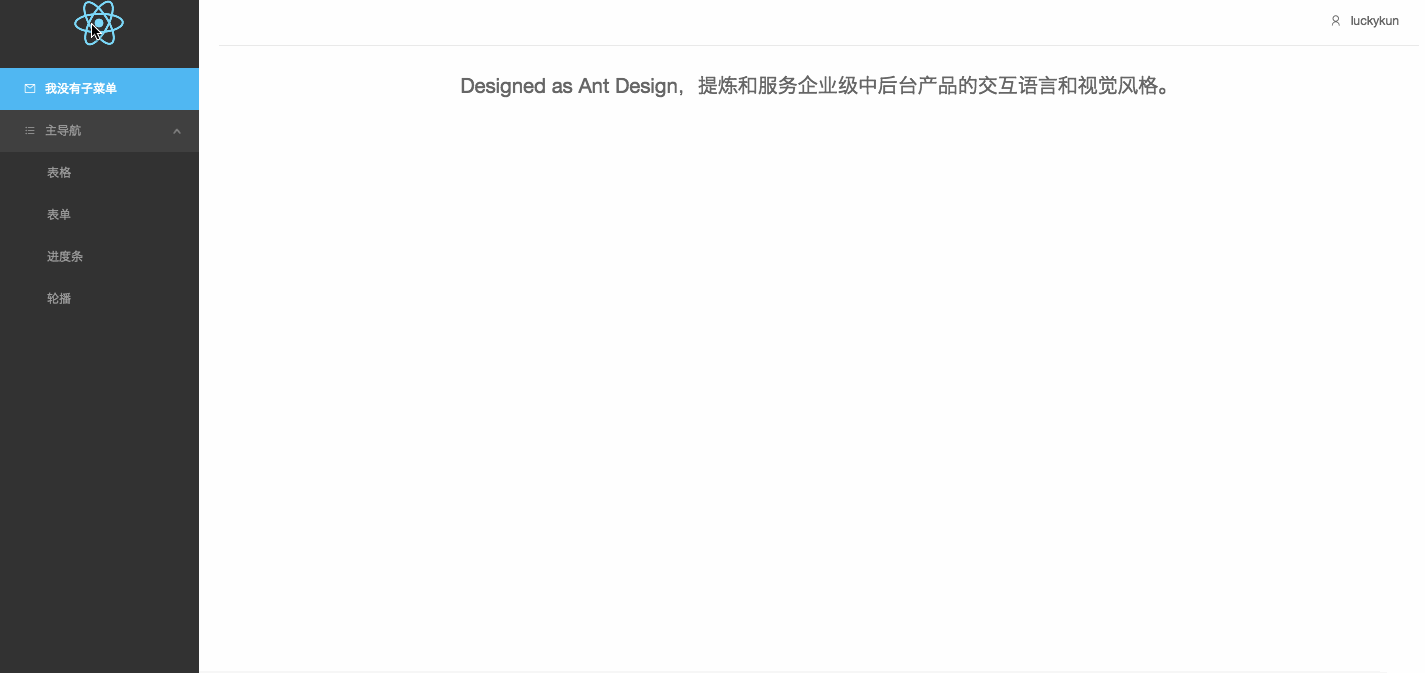React框架已經火了好長一段時間了,再不學就out了! 對React還沒有瞭解的同學可以看看我之前的一篇文章,可以快速簡單的認識一下React。 "React入門最好的實例-TodoList" 自己從開始接觸react一竅不通,到慢慢的似懂非懂,通過各種途徑學習也有一陣了。學習過程中還會接觸到很多 ...
React框架已經火了好長一段時間了,再不學就out了!
對React還沒有瞭解的同學可以看看我之前的一篇文章,可以快速簡單的認識一下React。React入門最好的實例-TodoList
自己從開始接觸react一竅不通,到慢慢的似懂非懂,通過各種途徑學習也有一陣了。學習過程中還會接觸到很多新的東西,比如ES6、webpack,過程艱辛誰人懂,見坑填坑慢慢來。今天把學習過程過濾了一下,只說項目實際需要用的東西,總結了一套能看到的東西,分享給大家,希望能讓讀者少踩一些坑!
本文看點
實際項目效果:最終你只需要在本地啟一個服務,就能看到運行效果。webpack的配置:項目實戰中常用的插件和配置方法。React用法:React在MVC(模型Model-視圖View-控制器Controller)層面上主要扮演了視圖的作用。我們可以學習它在項目中到底該如何使用。React-router配置:單頁面應用(SPA)離不開路由,我們可以學習在項目中React-router如何配置。ES6語法:我們會用到一些在項目中常見的ES6語法。antd的使用:螞蟻金服出的一款基於React的框架,我們可以學習如何去使用。
項目效果
項目代碼已經上傳至github,項目代碼github地址。大家把代碼下載下來之後,跟隨以下步驟即可在本地看到效果。
首先安裝node環境。
全局安裝webpack
npm install webpack -g安裝項目依賴
npm install開發模式,啟動本地服務
npm run dev至這一步成功後,在瀏覽器輸入
localhost:8888就能看到如下圖的效果了。
在build文件夾下打包
npm run build
webpack配置
基於React的項目配合webpack來打包管理最合適不過了。但是不學不知道,一學嚇一跳,webpack的學習TM複雜了,各種報錯,各種坑,就是webpack讓我在學習的過程中一度想要放棄。然而過來人告訴你,堅持就是勝利!
學會怎麼配置webpack,是獨立管理項目的第一步。每個用webpack管理的項目都有一個webpack.config.js文件,先來看看這個項目的webpack.config.js文件:
'use strict';
var ExtractTextPlugin = require("extract-text-webpack-plugin"); //css單獨打包
var CommonsChunkPlugin = require("webpack/lib/optimize/CommonsChunkPlugin");
module.exports = {
devtool: 'eval-source-map',
entry: {
main: './src/entry.js', //唯一入口文件
vendor: ['react'] //這裡是依賴的庫文件配置,和CommonsChunkPlugin配合使用可以單獨打包
},
output: {
path: './build', //打包後的文件存放的地方
filename: 'main.js', //打包後輸出文件的文件名
publicPath: 'http://localhost:8888/build/' //啟動本地服務後的根目錄
},
module: {
loaders: [
{ test: /\.js$/, loader: "jsx!babel", include: /src/},
{ test: /\.css$/, loader: ExtractTextPlugin.extract("style", "css!postcss")},
{ test: /\.scss$/, loader: ExtractTextPlugin.extract("style", "css!postcss!sass")},
{ test: /\.(png|jpg|gif)$/, loader: 'url?limit=819200'}
]
},
babel: {
presets: ['es2015', 'stage-0', 'react'],
plugins: ['transform-runtime', ['import', {
libraryName: 'antd',
style: 'css'
}]]
},
postcss: [
require('autoprefixer') //調用autoprefixer插件,css3自動補全
],
devServer: {
// contentBase: './src/views' //本地伺服器所載入的頁面所在的目錄
port: 8888,
colors: true, //終端中輸出結果為彩色
historyApiFallback: true, //不跳轉
inline: true //實時刷新
},
plugins: [
new ExtractTextPlugin('main.css'),
new CommonsChunkPlugin({
name: 'vendor',
filename: 'vendor.js'
})
]
}一個完整項目的基本webpack配置就是這些了,重要的配置項已經在上述代碼中作了註釋。另外,也可以深入學習,推薦看看這篇文章。webpack詳細指南
React用法
React本身真的非常簡單。你可以把一個頁面分為很多個組件的組成,而React就是開發這些組件的。所以React其實就是view層,說白了就是html,只不過每個組件是通過js創建的,每個組件還有自己的狀態和自己的方法。
React Component(一個組件)提供一個render方法以及其他可選的生命周期函數、組件相關的事件或方法定義。常用API就以下幾個:
constructor:構造函數class component extends React.Component { constructor(props) { super(props); this.state = { color: props.initialColor }; } }render:組件返回的dom內容(必須)componentWillMount:在render之前自動調用,你可以在這個方法裡面調用setState改變狀態,並且不會導致額外調用一次rendercomponentDidMount:在render之後自動調用,從這裡開始可以通過this.getDOMNode()獲取到組件的DOM節點componentWillUpdate: 組件收到新的state,更新view之前自動調用componentDidUpdate: 組件收到新的state,更新view完成之後自動調用
然後回到我們這個項目實例,拿代碼中的進度條組件(src-components-progress.js)代碼作為展示:
import React from 'react'; //引入react
import { Progress, Button } from 'antd'; //引入antd
const ButtonGroup = Button.Group;
class myProgress extends React.Component {
constructor(props) {
super(props)
this.state = { //初始化組件的狀態
percent: 0
}
}
increase() { //自定義函數
let percent = this.state.percent + 10;
if (percent > 100) {
percent = 100;
}
this.setState({ percent }); //設置組件的狀態
}
decline() { //自定義函數
let percent = this.state.percent - 10;
if (percent < 0) {
percent = 0;
}
this.setState({ percent });
}
render() {
return (
<div className="progress-wrap"> //類名使用className
<Progress percent={this.state.percent} />
<Progress type="circle" percent={this.state.percent} />
<ButtonGroup>
<Button type="ghost" onClick={this.decline.bind(this)} icon="minus" />
<Button type="ghost" onClick={this.increase.bind(this)} icon="plus" />
</ButtonGroup>
<span>點擊按鈕可以看到進度條的變化</span>
</div>
)
}
}
export default myProgress; //導出這個組件(ES6語法)代碼我已經給出了註釋,不做贅述。
React-router配置
獨立的前端應用離不開路由配置,就像angular框架也有自己的路由一樣。在React項目中使用路由,需要依賴React-Router模塊。我們直接來看看此項目中的路由配置:
import ReactDom from 'react-dom';
import { Router, Route, Link, hashHistory, IndexRoute, Redirect, IndexLink} from 'react-router';
ReactDom.render((
<Router history={hashHistory}> //路由容器
<Route path="/" component={Sider}> //一級路由,路徑為"/"時,載入“Sider”組件
<IndexRoute component={myIntroduce} /> //預設路由,載入“Sider”和“myIntroduce”組件
<Route path="myIntroduce" component={myIntroduce} /> //二級路由
<Route path="myTable" component={myTable} /> //二級路由
<Route path="myForm" component={myForm} /> //二級路由
<Route path="myProgress" component={myProgress} /> //二級路由
<Route path="myCarousel" component={myCarousel} /> //二級路由
</Route>
</Router>
), document.getElementById('app'));React的路由配置其實很簡單,就是把路徑和定義好的組件一一對應起來就好了。上述代碼結合實際運行效果,一看就明白。
ES6語法
我之前寫過一篇關於ES6常見語法的文章,總結ES6常用的新特性。
。
另外,上述貼出的代碼中已經出現過很多的ES6語法。ES6的學習就是見多學多的過程,多使用,多總結,自然就會了。
antd的使用
antd可以理解為是一個基於react的ui組件庫。引入這個庫之後,我們就可以直接使用很多現成的組件,比如按鈕、圖標、表單、菜單、導航等等。去antd官網發現更多牛逼的組件。
比如上面已經貼過的進度條組件:
import { Progress, Button } from 'antd'; //引入antd
const ButtonGroup = Button.Group; //按鈕組
......
<Progress percent={this.state.percent} /> //使用進度條組件,percent是組件提供的配置項
<Progress type="circle" percent={this.state.percent} />
<ButtonGroup>
<Button type="ghost" onClick={this.decline.bind(this)} icon="minus" />
<Button type="ghost" onClick={this.increase.bind(this)} icon="plus" />
</ButtonGroup>
......另外,由於antd組件比較多,所以庫文件比較大,所以我們在開發的時候可以按需引入對應的庫。webpack配置需要用到babel-plugin-import模塊。
babel: {
presets: ['es2015', 'stage-0', 'react'],
plugins: ['transform-runtime', ['import', {
libraryName: 'antd',
style: 'css'
}]]
}總結
上面的項目我已放到了Github上。基於react+antd的項目實例,喜歡的看管麻煩star一下啦!謝謝~
學習的過程枯燥艱辛,但是取得的成果卻令人興奮。所以我們還是要不忘初心,不忘學習!


